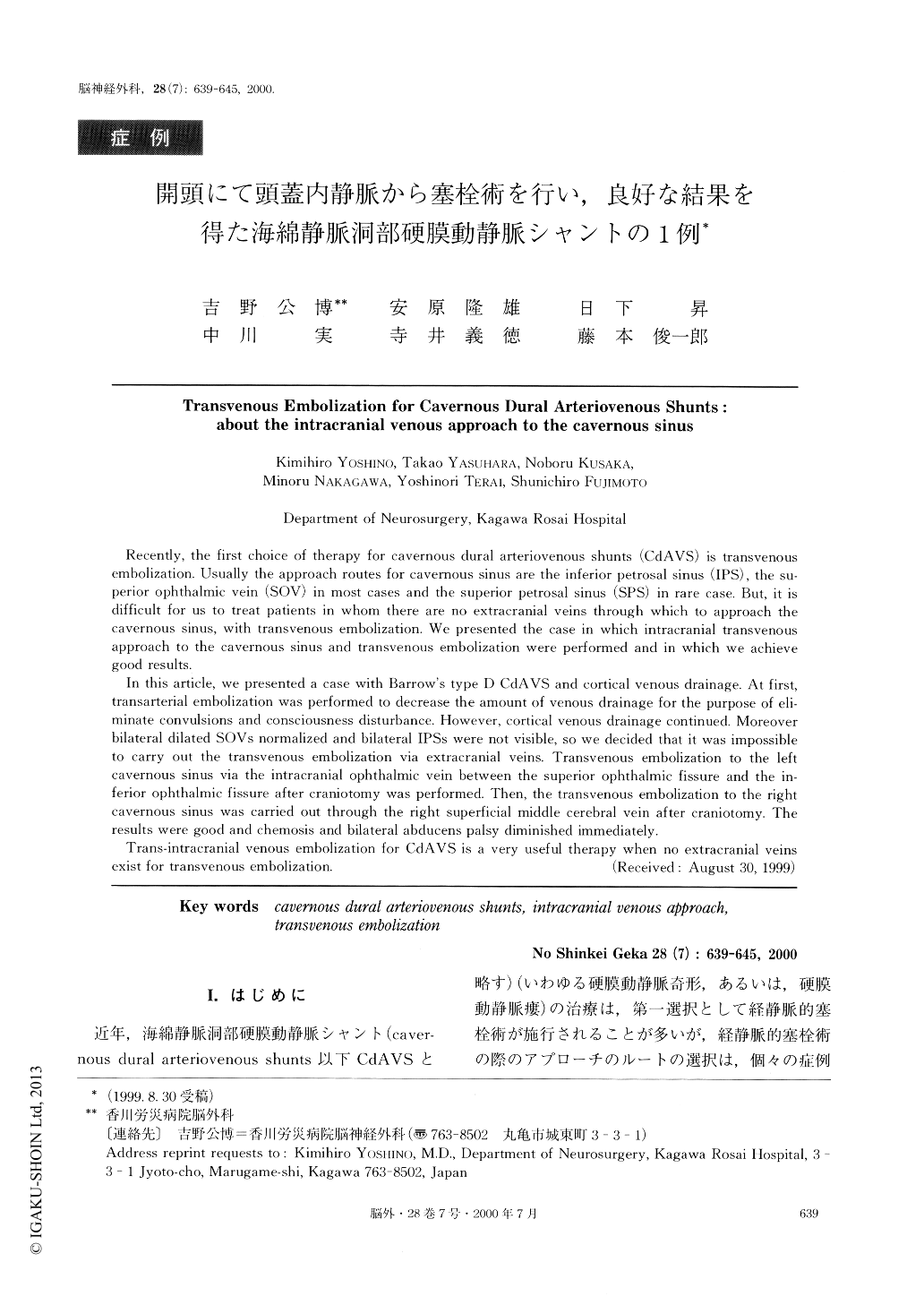Japanese
English
- 有料閲覧
- Abstract 文献概要
- 1ページ目 Look Inside
I.はじめに
近年,海綿静脈洞部硬膜動静脈シャント(caver-nous dural arteriovenous shunts以下CdAVSと略す)(いわゆる硬膜動静脈奇形,あるいは,硬膜動静脈瘻)の治療は,第一選択として経静脈的塞栓術が施行されることが多いが,経静脈的塞栓術の際のアプローチのルートの選択は,個々の症例のvenous drainageの形態によるところが大きい.大腿静脈(femoral vein:FVと略す)から下錐体静脈(inferior petrosal sinus:IPSと略す)や時に上錐体静脈(superior petrosal sinus:SPSと略す)を経由し,海綿静脈洞(cavernous sinus:CSと略す)に至るルートや眼瞼を切開し上眼静脈(superior ophthalmic vein:SOVと略す)を直接穿刺して行う方法が一般的である3,6,9,11,12).しかし,時に頭蓋外静脈からのアプローチが困難となる症例に遭遇することがある.今回,頭蓋外静脈からのアプローチが困難となった症例に,開頭による頭蓋内静脈からのアプローチにて塞栓術を行い,良好な結果を得たので症例を呈示するとともに特に頭蓋内静脈からのアプローチの有用性や問題点について報告する.
Recently, the first choice of therapy for cavernous dural arteriovenous shunts (CdAVS) is transvenous embolization. Usually the approach routes for cavernous sinus are the inferior petrosal sinus (IPS), the su-perior ophthalmic vein (SOV) in most cases and the superior petrosal sinus (SPS) in rare case. But, it is difficult for us to treat patients in whom there are no extracranial veins through which to approach the cavernous sinus, with transvenous embolization. We presented the case in which intracranial transvenous approach to the cavernous sinus and transvenous embolization were performed and in which we achieve good results.
In this article, we presented a case with Barrow's type D CdAVS and cortical venous drainage. At first, transarterial embolization was performed to decrease the amount of venous drainage for the purpose of eli-minate convulsions and consciousness disturbance. However, cortical venous drainage continued. Moreover bilateral dilated SOVs normalized and bilateral IPSs were not visible, so we decided that it was impossible to carry out the transvenous embolization via extracranial veins. Transvenous embolization to the left cavernous sinus via the intracranial ophthalmic vein between the superior ophthalmic fissure and the in-ferior ophthalmic fissure after craniotomy was performed. Then, the transvenous embolization to the right cavernous sinus was carried out through the right superficial middle cerebral vein after craniotomy. The results were good and chemosis and bilateral abducens palsy diminished immediately. Trans-intracranial venous embolization for CdAVS is a very useful therapy when no extracranial veins exist for transvenous embolization.

Copyright © 2000, Igaku-Shoin Ltd. All rights reserved.


